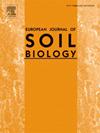Impact of grassland management intensity on associations between bacterial, fungal and plant communities
IF 3.3
2区 农林科学
Q1 ECOLOGY
引用次数: 0
Abstract
Understanding co-occurrences of different taxa is of both fundamental and applied relevance, for example, to understand ecosystem processes and to design monitoring programs for above- and belowground biodiversity. Plants and microorganisms form complex, interdependent relationships, which are exposed to and may be compromised by agricultural management. Here we assessed the effect of grassland management intensities on bacterial, fungal and plant communities and their associations. We further analyzed the potential of inferring information from taxa of one community on structural changes of the other communities with the aim of potentially enhancing the efficiency of biodiversity assessments by finding common indicator taxa. For that, bacterial, fungal and plant communities as well as environmental factors were assessed in 89 grassland sites of either extensive type (no fertilization, late and infrequent cuttings) or intensive type (fertilization, early and frequent cuttings) of management in the Swiss lowlands.
Bacterial, fungal and plant community structures as well as plant indicator values for soil nutrients and moisture differed between management types. Also, community homogeneity was significantly higher for all communities in the intensively managed grassland. For bacterial community structures, this was likely related to a smaller soil pH range in intensively managed grassland, while a lower fungal and plant richness may have caused more homogenous fungal and plant community structures in intensively managed grassland. Further, correlation strength among community structures dropped by 25–66 % from extensively to intensively managed grassland. Finally, indicator analysis suggested that future monitoring programs may use plant taxa to estimate expected effects on fungal communities and vice versa, but bacterial communities require additional assessment. Our results revealed a multifaceted and profound effect of management on bacterial, fungal and plant communities, which reinforces the conservation value of extensively managed grassland.
草地管理强度对细菌、真菌和植物群落关系的影响
了解不同分类群的共生现象具有基础和应用上的相关性,例如,了解生态系统过程和设计地上和地下生物多样性的监测程序。植物和微生物形成了复杂的、相互依存的关系,这种关系受到农业管理的影响,也可能受到农业管理的损害。本研究评估了不同草地管理强度对细菌、真菌和植物群落及其关联的影响。我们进一步分析了从一个群落的分类群推断其他群落结构变化信息的潜力,以期通过寻找共同的指示分类群来提高生物多样性评估的效率。为此,对瑞士低地89个粗放型(不施肥、晚插枝和不频繁插枝)和集约型(施肥、早插枝和频繁插枝)草地的细菌、真菌和植物群落以及环境因子进行了评估。细菌、真菌和植物群落结构以及植物对土壤养分和水分的指示值在不同管理类型之间存在差异。集约经营草地各群落群落均匀性均显著高于集约经营草地。对于细菌群落结构,这可能与集约管理草地土壤pH值范围较小有关,而真菌和植物丰富度较低可能导致集约管理草地真菌和植物群落结构更为均匀。从粗放型管理到集约型管理,群落结构的相关强度下降了25 ~ 66%。最后,指标分析表明,未来的监测计划可能会使用植物分类来估计对真菌群落的预期影响,反之亦然,但细菌群落需要额外的评估。我们的研究结果揭示了管理对细菌、真菌和植物群落的多方面和深刻的影响,从而加强了广泛管理的草地的保护价值。
本文章由计算机程序翻译,如有差异,请以英文原文为准。
求助全文
约1分钟内获得全文
求助全文
来源期刊

European Journal of Soil Biology
环境科学-生态学
CiteScore
6.90
自引率
0.00%
发文量
51
审稿时长
27 days
期刊介绍:
The European Journal of Soil Biology covers all aspects of soil biology which deal with microbial and faunal ecology and activity in soils, as well as natural ecosystems or biomes connected to ecological interests: biodiversity, biological conservation, adaptation, impact of global changes on soil biodiversity and ecosystem functioning and effects and fate of pollutants as influenced by soil organisms. Different levels in ecosystem structure are taken into account: individuals, populations, communities and ecosystems themselves. At each level, different disciplinary approaches are welcomed: molecular biology, genetics, ecophysiology, ecology, biogeography and landscape ecology.
 求助内容:
求助内容: 应助结果提醒方式:
应助结果提醒方式:


